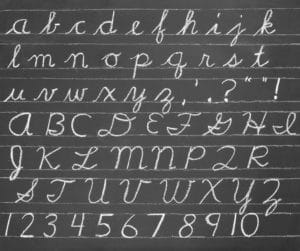
Cursive handwriting is being lost primarily because of the prominent digital landscape we now embrace. Many schools in the U.S. no longer teach cursive because of its removal from the Common Core State Standards. Calligraphy, a decorative form of handwriting, has also been declining. Calligraphists may still work on wedding invitations, advertising, or academic achievements like diplomas and degrees. Cursive writing now appears to be more of an art form rather than a regular aspect of life.
While electronic devices make life easier, handwriting still holds great value and benefits children more than a keyboard. Studies show that typing decreases brain activity, whereas cursive stimulates it. The National Math and Science Initiative, or NMS, delivers research on how handwriting helps children’s development and learning. Teaching handwriting skills proves invaluable to students. Children will master the art and have it to use throughout their entire life.

Here are some key takeaways from NMS that show the value of handwriting.
- One study shows that elementary students write faster than students who type. The handwriting students produced more content and expressed broader ideas. Practicing writing helps children understand complex and unfamiliar concepts.
- Research shows better retention and memory when you write down information by hand rather than type it. The skill of writing by hand has a profound role in students’ learning and helps develop critical thinking skills.
- Children who do not have consistent exposure to handwriting will misspell and misinterpret context because of the heavy reliance on electronics. Even “autocorrect” can get things wrong.
- Students who handwrite actively engage more in their learning and pay better attention than those who type. Writing increases a child’s productivity in a classroom and when doing homework.
- The repetition of handwriting stimulates the brain and enhances a student’s visual learning capacities. Writing also improves children’s language comprehension and vocabulary.
- Learning handwriting basics during early childhood enhances reading skills. Children who begin to write at an early age will also be able to learn cursive more easily.
- The process of handwriting also relaxes stress levels and emotional reactions in children. Studies looking at brain activity show that cursive writing has therapeutic benefits.
Erin Jensen, author of the book, Teaching with the Brain in Mind,” sums up handwriting in this NMS blog. He states writing improves memory, focus, prediction, attention, sequencing, estimation, patience, and creativity. This blog also contains research from a neurologist and other studies regarding handwriting.
Teachers and parents can set students up for academic success with structured handwriting lessons. Children who learn to handwrite also feel more confident as a student and sharpen their creative skills. So, how can children learn handwriting at home if the school does not teach it? Ironically and unsurprisingly, you can use several apps. Letter School and Cursive Touch and Write have games that teach handwriting. Dexteria offers hand exercises, and Ready To Print teaches pre-writing skills.
You can also teach cursive handwriting the “old-fashioned” way with pens, pencils, and paper. Evan-Moor’s educational blog provides a valuable guide to teach children contemporary or traditional cursive. Teachers, parents, and homeschoolers can choose whether to implement cursive in a curriculum. If the trends continue a few generations from now, cursive may be a relic. In the future, handwritten notes will be a fantastic discovery and ancient find, just like hieroglyphics.
To practice basic manuscripts, you can download this free activity from Art Projects for Young Children.
